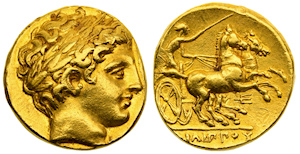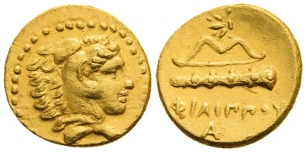Fine Coins Showcase
Antiquities Showcase
Show Empty Categories
Shop Search
Shopping Cart
My FORVM
Contact Us
About Forum
Shopping at Forum
Our Guarantee
Payment Options
Shipping Options & Fees
Privacy & Security
Forum Staff
Selling Your Coins
Identifying Your Coin
FAQs
zoom.asp
Home ▸ Catalog ▸ |Greek Coins| ▸ |Geographic - All Periods| ▸ |Macedonia| ▸ |Pella||View Options:   | | | | | | Pella was founded in 399 B.C. by King Archelaus (413 - 399 B.C.) as his capital. It was the seat Philip II and of his son, Alexander the Great. In 168 B.C., it was sacked by the Romans, and its treasury transported to Rome. Later the city was destroyed by an earthquake. By 180 A.D., Lucian could describe it in passing as "now insignificant, with very few inhabitants." |


Philip II expanded the size and influence of the Macedonian Kingdom but is perhaps best known as the father of Alexander the Great. He personally selected the design of his coins.SH96387. Gold stater, Le Rider pl. 62, 282A (D87/R216A); SNG ANS 144; SNG Cop 524; HGC 3 847, aEF, luster, attractive style, edge shaved in antiquity, weight 7.518 g, maximum diameter 17.2 mm, die axis 0o, Macedonia, Pella mint, c. 340 - 328 B.C.; obverse laureate head of Apollo right; reverse charioteer in fast biga right, kentron in right hand, reins in left hand, trident head right below horses forelegs, ΦIΛIΠΠOY exergue; ex Roma Numismatics e-sale 70 (7 May 2020), lot 509; Morton & Eden Ltd. ; SOLD
Macedonian Kingdom, Philip II of Macedonia, 359 - 336 B.C.


Philip II expanded the size and influence of the Macedonian Kingdom but is perhaps best known as the father of Alexander the Great. He personally selected the design of his coins.SH87496. Gold stater, Le Rider 113 (D53/R86), SNG ANS 130, SNG Cop 530, SNG Berry 87, SNG Munchen -, SNG Saroglos -, SNG Alpha Bank -, Choice VF, well centered, light bumps and marks, weight 8.518 g, maximum diameter 18.9 mm, die axis 0o, Macedonia, Pella mint, c. 340 - 328 B.C.; obverse laureate head of Apollo right; reverse charioteer in fast biga right, kentron in his right hand, reins in his left hand, thunderbolt below horses, ΦIΛIΠΠOY in exergue; SOLD
Macedonian Kingdom, Philip II of Macedonia, 359 - 336 B.C.


Philip II expanded the size and influence of the Macedonian Kingdom but is perhaps best known as the father of Alexander the Great. He personally selected the design of his coins.SH62343. Gold stater, Le Rider pl. 57 ff. (no die matches), SNG ANS 172 ff. (same), SNG Alpha Bank -, VF, ex jewelry, scratches, weight 8.454 g, maximum diameter 18.5 mm, die axis 0o, Pella mint, 340 - 328 B.C.; obverse laureate head of Apollo right; reverse ΦIΛIΠΠOY (in exergue), charioteer in biga right, kantharos below horses; marks from jewelry mount, polished; fine style; ex Stack's Bowers and Ponterio, Sale 168, lot 20395; SOLD
Macedonian Kingdom, Philip III Arrhidaios, 323 - 317 B.C.


Struck shortly after Alexander the Great's death during the joint reign of Philip III, Alexander's mentally disabled brother, and the infant king Alexander IV, Alexander's infant son with the Bactrian princess Roxana. The two were made joint kings by Alexander's generals who, knowing they could not rule, only intended to use them as pawns. Philip III was imprisoned upon his return to Macedonia, and in 317 B.C. he was executed under orders from Olympias. Alexander IV and his mother Roxana were executed by the boy's regent, Kassander, in 311 B.C. We don't know if this coin was posthumously struck in the name of Philip II, or struck in the name of the reigning (but not actually ruling) Philip III.SH112514. Gold stater, Le Rider pl. 57 ff., SNG ANS 172 ff., SNG Cop 529, SNG Alpha Bank -, VF, light bumps and marks, weight 8.557 g, maximum diameter 19.3 mm, die axis 0o, Pella mint, 323 - 317 B.C.; obverse laureate head of Apollo right; reverse charioteer driving biga right, kentron in right hand, reins in left hand, kantharos (control) below, ΦIΛIΠΠOY in exergue; ex BSD Coins; SOLD
Kingdom of Thrace, Lysimachos, 305 - 281 B.C., Portrait of Alexander the Great


Athena is the Greek goddess of wisdom, courage, inspiration, civilization, law and justice, strategic warfare, mathematics, strength, strategy, the arts, crafts, and skill. She was believed to lead soldiers into battle as the war goddess Athena Promachos. The Parthenon on the Athenian Acropolis was dedicated to her, along with numerous other temples and monuments across Europe, West Asia, and North Africa. Her usual attribute is the owl and Nike is her frequent companion.SH30617. Gold stater, Thompson 241, Müller 504 var, aEF, light rim marks, weight 8.519 g, maximum diameter 18.0 mm, die axis 90o, Pella mint, obverse diademed head of Alexander the Great right wearing the horn of Ammon; reverse Athena Nikephoros enthroned left, Nike crowning name in extended right hand, left arm rests on grounded round shield, transverse spear against right side, BAΣIΛEΩΣ (king) downward on right, ΛYΣIMAXOY (Lysimachos) downward on left, monogram left, K in exergue; SOLD
Kingdom of Thrace, Lysimachos, 305 - 281 B.C., Portrait of Alexander the Great


SH25048. Gold stater, Müller 504, cf. Thompson 241 (K in ex), EF, some luster, a few minor nicks, tight flan, weight 8.514 g, maximum diameter 20.0 mm, die axis 0o, Pella mint, posthumous, 286 - 281 B.C.; obverse diademed head of Alexander the Great right wearing the horn of Ammon; reverse Athena Nikephoros enthroned left, Nike crowning name in extended right hand, left arm rests on grounded round shield decorated with Gorgoneion, transverse spear against right side, BAΣIΛEΩΣ (king) downward on right, ΛYΣIMAXOY (Lysimachos) downward on left, monogram left, K(?) in exergue; SOLD
Macedonian Kingdom, Demetrius I Poliorketes, 306 - 283 B.C.


This type was issued in preparation for Demetrios' invasion of Asia Minor. Demetrios was defeated, imprisoned by Seleukos and died in captivity in 283 B.C. The bull's horns suggest his relationship to Poseidon is the same as Alexander's to Zeus Ammon. The portrait is individualized, but evokes the image of Alexander. Demetrios was the first to assimilate elements of Alexander's deified portrait and the first living ruler to portray himself as a god on coins. -- www.lawrence.edu SH75316. Silver tetradrachm, Newell p. 97, 91 and pl. VIII, 12, SNG Cop 1179 var., gVF, superb portrait, tight flan, a few marks, weight 17.018 g, maximum diameter 29.1 mm, die axis 15o, Macedonia, Pella mint, c. 289 - fall 288 B.C.; obverse Demetrios diademed head right with horns of a bull, the animal sacred to Demetrios' patron deity, Poseidon; reverse BAΣIΛEΩΣ ΔHMHTPIOY, Poseidon standing left, right foot on rock, trident in left (apparently inspired by the Lateran Poseidon, a statue by Lysippos, court sculptor of Alexander), KE monogram left, H right; ex Forum (2007), ex Harlan Berk; SOLD
Macedonian Kingdom, Philip III and Alexander IV, 323 - 315 B.C., Types of Philip II


Philip II coin types remained prominent in the northern regions of the Macedonian Kingdom long after his death. This coin was struck at Pella under Antipater or Polyperchon after Alexander's death when the kingdom was nominally ruled by Alexander's mentally disabled half-brother Philip III Arrhidaeus, son of Philip II and Philinna, and Alexander IV, the great conqueror's young son. The two were made joint kings by Alexander's generals who only used them as pawns. Philip III was imprisoned upon his return to Macedonia, and in 317 B.C. he was executed under orders from Olympias. Alexander IV and his mother Roxana were executed by the boy's regent, Kassander, in 311 B.C.SH84818. Gold 1/4 stater, CNG auction 88 (14 Sep 2011), lot 149 (same dies, gVF, $5,055 plus fees); Le Rider 131 var. (club left); SNG ANS 237 var. (same), aEF, light marks, weight 2.124 g, maximum diameter 11.4 mm, die axis 180o, Macedonia, Pella mint, c. 323 - 317 B.C.; obverse head of Herakles right, wearing Nemean lion scalp headdress knotted at neck; reverse bow with string downward above club right, bee right above bow, ΦIΛIΠΠOY over A below club; extremely rare variant; SOLD
Macedonian Kingdom, Philip III and Alexander IV, 323 - 315 B.C., Types of Philip II


Philip II coin types remained prominent in the northern regions of the Macedonian Kingdom long after his death. This coin was struck after Alexander's death when the kingdom was nominally ruled by Alexander's mentally disabled half-brother Philip III Arrhidaeus, son of Philip II and Philinna, and Alexander IV, the great conqueror's young son. The two were made joint kings by Alexander's generals who only used them as pawns. Philip III was imprisoned upon his return to Macedonia, and in 317 B.C. he was executed under orders from Olympias. Alexander IV and his mother Roxana were executed by the boy's regent, Kassander, in 311 B.C.SH72301. Silver tetradrachm, Le Rider p. 68 and pl. 22, 530 (D281/R437); SNG Lockett 1414, SNG ANS 450 var. (shield under foreleg), SNG Alpha Bank 276 var. (same), SNG Saroglos -, aEF, excellent centering, graffiti, weight 13.299 g, maximum diameter 24.4 mm, die axis 135o, Macedonia, Pella mint, c. 323 - 315 B.C.; obverse laureate head of Zeus right; reverse ΦIΛIΠΠOY, nude youth pacing right on horseback, palm frond in right, reins in left, coiled snake below, Boeotian shield in exergue; SOLD
Macedonian Kingdom, Philip II of Macedonia, 359 - 336 B.C.


Philip II became the ruler of all Greece when he defeated the Athenians at the Battle of Chaeroneia in 338 B.C. Philip personally selected the design of his coins. His horse, on the reverse of this coin, won a race in the Olympic Games in 356 B.C., the year his son Alexander the Great was born.SH84347. Silver tetradrachm, Le Rider 248 (D116/R428); SNG ANS 504; SNG Cop 552; SNG Berry 116, gVF, superb style, bold high relief, well centered on a tight flan, rose toning, weight 14.422 g, maximum diameter 25.3 mm, die axis 180o, Macedonia, Pella mint, c. 340 - 328 B.C.; obverse laureate head of Zeus right; reverse ΦIΛIΠΠOY, naked youth on horse pacing right, holding palm frond, bunch of grapes on vine with leaves below; ex Wolfshead Gallery (Ridgewood, NJ); SOLD

You are viewing a SOLD items page.
Click here to return to the page with AVAILABLE items.
The sale price for a sold item is the private information of the buyer and will not be provided.



REFERENCES
Page created in 1.484 seconds.






